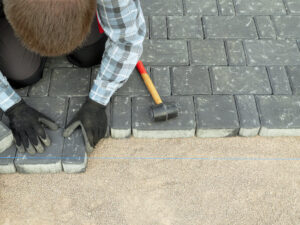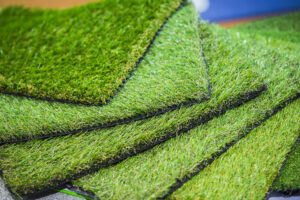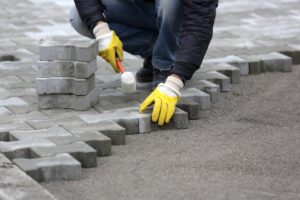While cleaning a floor doesn’t sound like a super-complex chore, there are many things that can go wrong. It’s hard to believe that a simple mop can cause damage to a stone floor, but it’s definitely a possibility, and more importantly – you should know how to avoid these situations, especially if you have a travertine floor.
We have made a list of dos and don’ts of how to clean travertine so that you can both prevent and avoid damaging your floors. The critical thing to point out is that these tips don’t require you to purchase a special mop or spend copious amounts of money on cleaning agents and solutions. Instead, they are simple, easy, affordable, and anyone can use them.
What Is Travertine?
Before we focus on cleaning, it’s essential to get familiar with travertine itself. Travertine is a natural stone, much like granite and marble. It is formed in limestone caves through the process of condensation of calcium carbonate. This physical reaction is responsible for the incredible hardness of travertine.
The difference between, let’s say, granite and travertine is that travertine does not go through a process called “metamorphosis,” whereas granite (and other natural stones) does. Instead of being shiny or sparkling, this natural stone features tiny pores caused by the bubbles of carbon dioxide being trapped while the material sets. These pores make travertine somewhat unique, but they are also the thing that makes this stone sensitive to specific cleaning methods.
Travertine is easy to install, available in several colors, and in general quite sought-after by many. However, while it’s reliable, hard, and resilient, it’s not always the best choice for every room in your house.

How to Clean Travertine
Over time, the tiny pores will get filled with dirt and dust; it’s inevitable. Additionally, new holes could appear over time as a result of wear and tear, especially if you have a travertine floor in a room that’s frequently used throughout the day, like, for example – your living room.
Here are a couple of tips you should keep in mind when dealing with this natural stone:
-
Do Not Use Abrasive Cleaning Products
This is more of a “avoid using” instead of “don’t ever use” type of advice, but it’s good to keep the adverse effects of strong cleaning products in mind. The concept is pretty simple – abrasive cleaning products could react with travertine and cause discoloration and minor damage. While the potential damage is somewhat trivial, the fact that discoloration is a possibility should be more than enough to deter you from using particularly strong cleaning products.
The best solution here is to use baking soda and mild, non-acidic dish soap when wiping your floors. Avoid using vinegar and citrus!
-
Use Microfiber Mops
A typical cotton mop will only push the water and dirt around instead of picking it up. Furthermore, that dirty water will eventually end up back in those tiny pores and render your efforts more or less useless. That’s why it’s essential to use a microfiber mop as it tends to absorb the dirty water rather than push it around. It is true that microfiber mops cost more than typical ones, but rest assured it’s a worthy investment.
-
Pay Attention to Grout Lines
Grout lines are used for filling the gaps between tiles. They are usually made of cement, water, and sand. Many people tend to neglect grout lines when washing their floors, which is a significant oversight because grout lines are a perfect breeding ground for mold, grime, and dirt. Whenever you’re wiping your floor, make sure to devote some time to cleaning the grout lines too. Fortunately, if they ever get damaged beyond repair, you can always fully replace them without having to break down the whole floor.
-
Seal Your Floors
Even though this isn’t cleaning advice per se, it still deserves to be mentioned. If you’re looking to avoid the inevitable hassles tied to having unprotected tiles of travertine, consider sealing it. There are two types of sealants, the first being a deep penetrating material that will clog the pores and the second being a surface barrier that will create a thin layer of material foreseen to protect the stone from discoloration and staining.
The barrier surface coating should be reapplied every few years to keep your floor in pristine condition.
The Advantages of Travertine
Now that you have the basic idea of how to clean your floors but aren’t yet sure whether you should opt for this type of stone as opposed to dozens of other types, here are a couple of advantages of travertine that should persuade you to consider installing it.
-
Exceptional Durability
One of the primary reasons why many homeowners decide to pave their floors with travertine is because it’s incredibly durable and can withstand quite a beating without ever showing signs of damage. Some signs of wear and tear can show up over time, but that just adds a distinct characteristic that resembles building blocks from ancient times. In fact, many ancient monuments contain or were made of travertine for hundreds, if not thousands of years.

-
Easy to Repair or Replace
Yet another excellent feature of travertine is that it comes in tiles and is thus quite easy to replace a single damaged tile rather than having to break down the whole floor. While it is exceptionally durable, that doesn’t mean it’s unbreakable. However, as long as you find a replacement piece of the same color, you don’t have to worry about repairs.
-
Prestigious and Subtle
While these two words can be considered antonyms, travertine is an exception because it’s both subtle and prestigious at the same time. Since it’s a natural stone, many people see travertine as nature’s work of art. On the other hand, when you open the door of your house and walk in, the floor will not stand out and draw your attention immediately. Instead, your eyes will slowly absorb its beauty and earthy tones.
-
Easy Maintenance
Even though there are some things you should keep in mind when wiping your floors, the overall concept is pretty simple and straightforward. All you have to remember is to avoid using aggressive chemicals, cheap cotton mops, and as we’ve mentioned – never forget about the grout lines. As far as the frequency of cleaning goes, you should do it at least once a week and combine it with regular vacuuming. You don’t need a fancy travertine floor cleaner or products with meaningless buzzwords as long as you stick to using the recommended solutions and doing it weekly.
What did you think about our article? Did it help you find a better way to clean your floors? If you’re interested in finding more about maintenance, benefits, and other properties of natural stones, don’t hesitate to read our other articles! In case you require installation services, check out our Services page, and contact us if you find something of interest!




